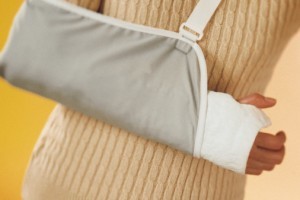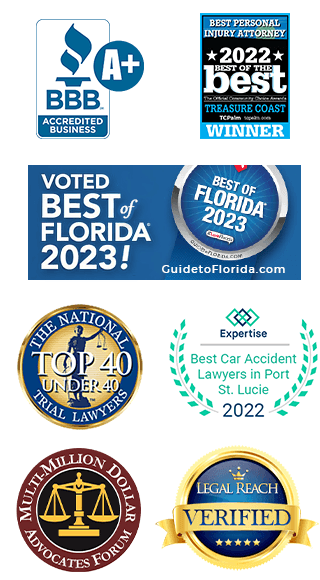

Florida Fracture Injury Lawyer
 Bone fracture injuries are common. WebMD says the average person suffers at least two fractures over a lifetime. But a fracture injury in childhood, when bones heal quickly and properly, is different from a fracture suffered by an adult. As we age, bones do not heal as well. It becomes harder to regain the muscle strength lost while a broken limb or hip is immobilized for recovery.
Bone fracture injuries are common. WebMD says the average person suffers at least two fractures over a lifetime. But a fracture injury in childhood, when bones heal quickly and properly, is different from a fracture suffered by an adult. As we age, bones do not heal as well. It becomes harder to regain the muscle strength lost while a broken limb or hip is immobilized for recovery.
Fractures occur in accidents such as car, truck and motorcycle accidents, as well as in slip-and-fall accidents. In older adults, hip fractures suffered in falls often result in long-term functional impairment, nursing home admission and increased mortality, the U.S. Centers for Disease Control and Prevention (CDC) says.
When someone else’s negligence causes a fracture injury, they should be held accountable for the injured party’s pain and suffering, and their financial losses. Philip DeBerard, Injury Attorney, helps victims of fracture injuries suffered in slip-and-fall accidents, car crashes and other accidents across South Florida and the Treasure Coast, including Stuart, Port St. Lucie, Okeechobee, Fort Pierce, Jupiter, Palm Beach and Vero Beach. For a free consultation, call us today toll free or use our online form.
Broken Bone Injuries
“Fracture” is the term used by doctors (and lawyers) for broken bones. The American Academy of Orthopaedic Surgeons (AAOS) explains that bones are rigid. But they also bend or “give” some when an outside force is applied. A bone breaks when too much force is applied by either a single blow, twisting or repeated stress.
Common types of fractures include:
- Greenstick fracture – The bone is bent, causing an incomplete fracture. This type occurs most often in children.
- Stress fracture – This is an overuse injury. It occurs when muscles become fatigued and are unable to absorb added shock. This is often a sports or workplace injury.
- Stable fracture – The broken ends of the bone line up and are barely out of place.
- Open or compound fracture – The skin may be pierced by the bone or by a blow that breaks the skin at the time of the fracture. The bone may or may not be visible.
- Transverse fracture – This type of fracture has a horizontal fracture line.
- Oblique fracture – This type of fracture has an angled pattern.
- Comminuted fracture – In this type of fracture, the bone shatters into three or more pieces.
- Impacted or buckle fracture – In this type of fracture, the bone’s ends are driven into each other.
Fractured bones are treated by realigning the broken bones and allowing them time to heal. To heal, a fracture must be immobilized – usually with a cast, splint or brace, depending on the severity of the fracture. More serious fractures may require the patient to be placed into traction, in which a weighted system slowly realigns broken bones.
In cases where the skin and other soft tissues around the fracture are badly damaged, a system of pins and screws may be used to hold broken bones together as they heal. “External fixation” refers to pins and screws that hold the bone in place until surgery can be performed, at which time rods, pins and screws are used to hold a badly damaged bone together. This is known as “internal fixation.”
Active children, or teens and young adults involved in team sports like football and soccer or individual sports like climbing or motocross biking, are less likely to suffer fractures. As adults age and become less active, fracture injuries usually occur in an accident, like a car crash, slip-and-fall accident or a fall at their workplace. Older adults, unfortunately, often suffer fractures in falls.
Hip Fracture Injury in Older Adults
Each year, more than 300,000 Americans age 65 and up are hospitalized due to a hip fracture, says the US Centers for Disease Control and Prevention (CDC). In Florida alone, 22,415 older adults suffered a hip fracture that sent them to the hospital in 2020, according to state Department of Health data.
A vast majority of these fractures are caused by falling accidents, such as by tripping on the floor or slipping on stairs. These slip-and-fall accidents can happen at a store or business, on a public sidewalk or street, or in a private home.
Treatment for a hip fracture typically includes surgery followed by admission to a nursing home and extensive rehabilitation.
In some hip fractures, the tip of the femur — which is the “ball” of the hip’s ball-and-socket joint — is damaged to the point that even with proper realignment, the cartilage and underlying supporting bone do not receive adequate blood, the AAOS explains. Over time, the head of the femur becomes misshapen, and the joint does not operate correctly.
In older patients, the chance that the head of the femur is damaged in this way is higher. This is corrected by hip replacement surgery to replace part of or all of the hip joint with an artificial hip.
One out of five hip fracture patients dies within a year of their injury, the CDC says.
Contact a Florida Fracture Injury Lawyer Today
Since 1975, the fracture injury attorneys of Philip DeBerard, Injury Attorney, have investigated the circumstances of thousands of slip-and-fall accidents, car accidents and similar injury-causing incidents on behalf of clients in South Florida and the Treasure Coast. If you or a loved one has suffered a fracture injury, you may have a right to money for your injuries and losses.
A Florida fracture injury victim who was hurt in an accident that was not their fault has a right to seek compensation for their injuries and other losses. If a property owner has failed in their duty to the public to make sure their property is safe for visitors, they can be held accountable.
From our office in Stuart, Philip DeBerard, Injury Attorney, has obtained millions of dollars in compensation for accident victims throughout the state of Florida, and have offices in Stuart, Port St. Lucie, Vero Beach, Okeechobee, Palm Beach Gardens and West Palm Beach.
We can put our legal team to work on your case right away. Call us today toll free or fill out our online contact form to arrange a free consultation.
Injured?
Request A Free Case Evaluation




